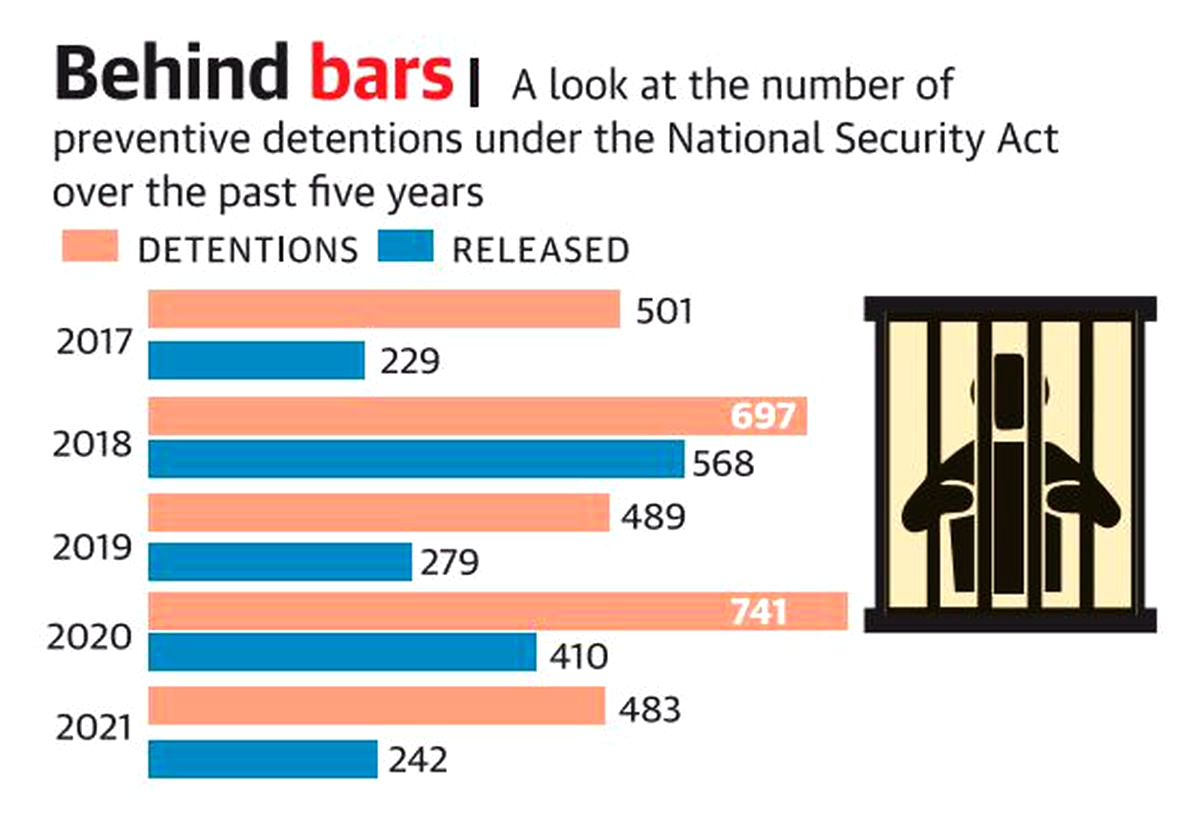The Rise in Preventive Detention | 07 Sep 2022
For Prelims: Preventive detention, Punitive detention, Unlawful Activities (Prevention) Act, National Crime Records Bureau (NCRB)
For Mains: Issues and Solutions of Preventive Detention
Why in News?
According to the latest crime statistics released by the National Crime Records Bureau (NCRB), there is a rise in Preventive detentions in 2021 of about 23% compared to 2020, with over 1.1 lakh people being placed under preventive detention.
What is Preventive Detention?
- Article 22: Article 22 of the Indian Constitution grants protection to persons who are arrested or detained.
- Two Types of Detentions:
- Preventive detention is when a person is held in police custody only on the basis of a suspicion that they would conduct a criminal act or cause harm to society.
- The police have the authority to hold anyone they suspect of committing a criminal offence and also to make arrests without a warrant or a magistrate’s authorization in certain cases.
- Punitive detention, which means detention as a punishment for a criminal offence. It occurs after an offence is actually committed, or an attempt has been made towards the commission of that crime.
- Preventive detention is when a person is held in police custody only on the basis of a suspicion that they would conduct a criminal act or cause harm to society.
- Two Types of Detentions:
What are the Key Highlights of the National Crime Records Bureau (NCRB) Data?
- The Highest number of Detention: A total of over 24,500 people placed under preventive detention were either in custody or still detained as of the end of 2021, the highest since 2017 when the NCRB started recording this data.
- State and Union Territories: Tamil Nadu followed by Telangana and Gujarat recorded most preventive detentions in 2021 among the States while Jammu and Kashmir recorded the highest number of such detentions in Union Territories (UTs).
- The Relative Preventive Laws:
- National Security Act: The NCRB data showed that the number of people arrested under the National Security Act (NSA) had dipped significantly compared to 2020.
- Preventive detentions under the NSA peaked in 2020 at 741. This number dropped to 483 in 2021.
- The Goonda Act
- Prevention of Illicit Traffic in Narcotic Drugs and Psychotropic Substances Act, 1988
- Public Safety Act (PSA)
- Narcotic Drug and Psychotropic Substance Act (NDPS),1985
- Prohibition of Insider Trading (PIT)
- Prevention of Black marketing and Maintenance of Supplies of Essential Commodities Act, 1980(PBMSECA)
- Further, a category classified as “Other Detention Acts”, under which most of the detentions were registered Since 2017, the highest number of persons to be placed under preventive detention has consistently been under the “Other Detention Acts” category.
- National Security Act: The NCRB data showed that the number of people arrested under the National Security Act (NSA) had dipped significantly compared to 2020.
- Issues:
- Misuse of other Acts: There are several laws like the Unlawful Activities (Prevention) Act and Maharashtra Control of Organised Crime Act which also provide for making preventive detentions.
- Manipulation by Government Officials: District magistrates and the police also often make preventive detentions to control law and order in emerging communal clashes or clashes between any two communities, even when it might not always lead to public disorder.
- Supreme Court’s View: In July 2022, a Vacation Bench of the Supreme Court, while setting aside the preventive detention order issued for a chain-snatcher in Telangana, observed that these powers accorded to the State were “exceptional” and that since they affect the liberty of an individual, they should be used sparingly.
- The court had also noted that these powers should not be used to control ordinary law and order problems.

